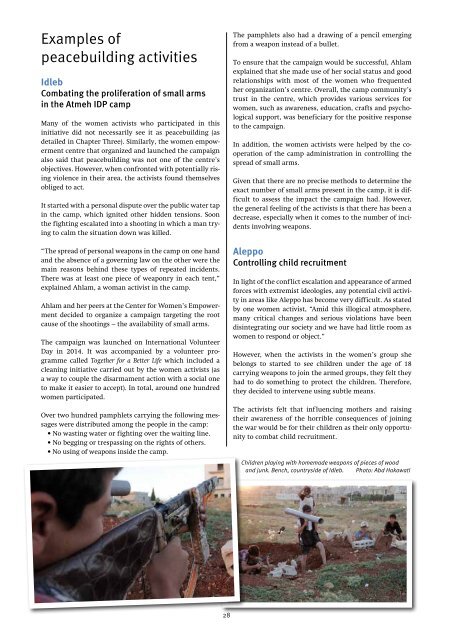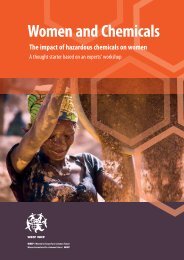future now”
YAO19
YAO19
You also want an ePaper? Increase the reach of your titles
YUMPU automatically turns print PDFs into web optimized ePapers that Google loves.
Examples of<br />
peacebuilding activities<br />
Idleb<br />
Combating the proliferation of small arms<br />
in the Atmeh IDP camp<br />
Many of the women activists who participated in this<br />
initiative did not necessarily see it as peacebuilding (as<br />
detailed in Chapter Three). Similarly, the women empowerment<br />
centre that organized and launched the campaign<br />
also said that peacebuilding was not one of the centre’s<br />
objectives. However, when confronted with potentially rising<br />
violence in their area, the activists found themselves<br />
obliged to act.<br />
It started with a personal dispute over the public water tap<br />
in the camp, which ignited other hidden tensions. Soon<br />
the fighting escalated into a shooting in which a man trying<br />
to calm the situation down was killed.<br />
“The spread of personal weapons in the camp on one hand<br />
and the absence of a governing law on the other were the<br />
main reasons behind these types of repeated incidents.<br />
There was at least one piece of weaponry in each tent,”<br />
explained Ahlam, a woman activist in the camp.<br />
Ahlam and her peers at the Center for Women’s Empowerment<br />
decided to organize a campaign targeting the root<br />
cause of the shootings – the availability of small arms.<br />
The campaign was launched on International Volunteer<br />
Day in 2014. It was accompanied by a volunteer programme<br />
called Together for a Better Life which included a<br />
cleaning initiative carried out by the women activists (as<br />
a way to couple the disarmament action with a social one<br />
to make it easier to accept). In total, around one hundred<br />
women participated.<br />
Over two hundred pamphlets carrying the following messages<br />
were distributed among the people in the camp:<br />
• No wasting water or fighting over the waiting line.<br />
• No begging or trespassing on the rights of others.<br />
• No using of weapons inside the camp.<br />
The pamphlets also had a drawing of a pencil emerging<br />
from a weapon instead of a bullet.<br />
To ensure that the campaign would be successful, Ahlam<br />
explained that she made use of her social status and good<br />
relationships with most of the women who frequented<br />
her organization’s centre. Overall, the camp community’s<br />
trust in the centre, which provides various services for<br />
women, such as awareness, education, crafts and psychological<br />
support, was beneficiary for the positive response<br />
to the campaign.<br />
In addition, the women activists were helped by the cooperation<br />
of the camp administration in controlling the<br />
spread of small arms.<br />
Given that there are no precise methods to determine the<br />
exact number of small arms present in the camp, it is difficult<br />
to assess the impact the campaign had. However,<br />
the general feeling of the activists is that there has been a<br />
decrease, especially when it comes to the number of incidents<br />
involving weapons.<br />
Aleppo<br />
Controlling child recruitment<br />
In light of the conflict escalation and appearance of armed<br />
forces with extremist ideologies, any potential civil activity<br />
in areas like Aleppo has become very difficult. As stated<br />
by one women activist, “Amid this illogical atmosphere,<br />
many critical changes and serious violations have been<br />
disintegrating our society and we have had little room as<br />
women to respond or object.”<br />
However, when the activists in the women’s group she<br />
belongs to started to see children under the age of 18<br />
carrying weapons to join the armed groups, they felt they<br />
had to do something to protect the children. Therefore,<br />
they decided to intervene using subtle means.<br />
The activists felt that influencing mothers and raising<br />
their awareness of the horrible consequences of joining<br />
the war would be for their children as their only opportunity<br />
to combat child recruitment.<br />
Children playing with homemade weapons of pieces of wood<br />
and junk. Bench, countryside of Idleb. Photo: Abd Hakawati<br />
28



